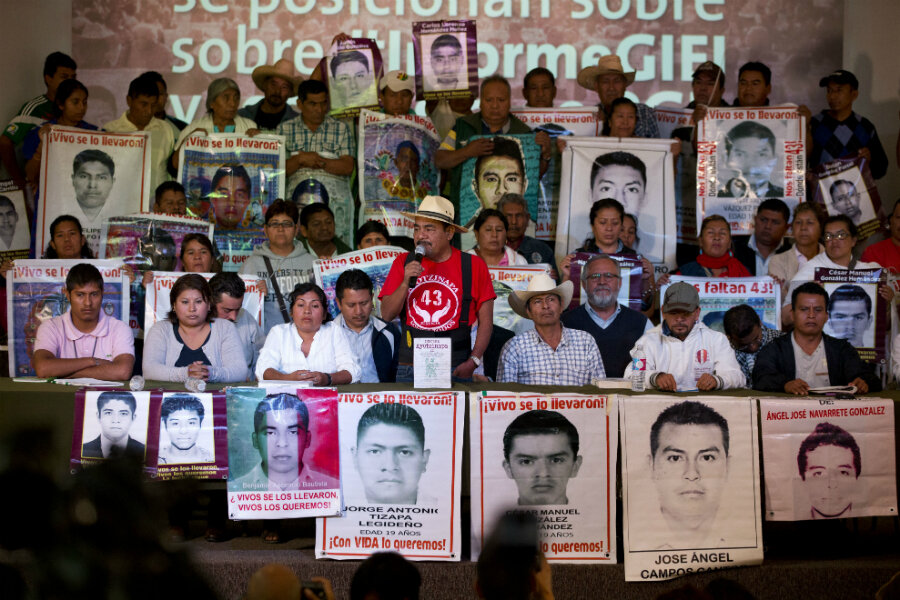Mexico's 43 missing students: Why the case is still a rallying cry
Loading...
| Mexico City
In September 2014, a group of 43 teacher’s college students were attacked and disappeared in the troubled southern state of Guerrero. The case gained international attention as their families and other Mexican citizens took to the streets to demand answers from the government. But more than a year and a half later, the government and an independent group of experts have two distinct takes on how events unfolded, raising questions about the future of the investigation and Mexico’s commitment to justice and human rights.
Q. Why does this case still matter?
The presumed murder of the 43 students served as a rallying cry for Mexicans, who for years have faced unsolved kidnappings, disappearances, or murders on a smaller and sometimes more personal scale. An estimated 26,000 people have gone missing since 2006, and 94 percent of crimes go unsolved.
Although the massive protests that swept the country – and the globe – have all but disappeared, the anger and frustration this case represents are very much alive. The president’s approval ratings sank in the aftermath of the tragedy, which become something of a “before and after the 43” moment. According to the Reforma newspaper, about 30 percent of the population approves of President Enrique Peña Nieto, a record low.
“The biggest challenge now is having Mexican society and the international community continue to pressure the Mexican government to remind them that this won’t be forgotten,” says Maureen Meyer, who directs the Mexico program at the Washington Office on Latin America. “If the government had its way, this would be one of the many historic unresolved crimes,” like the Tlatelolco massacre in the lead up to the 1968 Olympics here. To this day, it is still unconfirmed how many students and civilians were killed by the military and police. No one was ever held responsible for the attacks.
Q. What do we know about the students' disappearances?
The story of what happened – and whether the case is closed – depends on whom you ask. The government has stood by its findings, issued shortly after the disappearances, that the students were rounded up by local police and handed off to a drug gang, which took them to a nearby trash dump. There, the students were incinerated en masse, and their ashes disposed of in a river.
DNA tests conducted in an Austrian lab using bone fragments from the burn site have confirmed one student’s remains.
At the behest of the victims’ families, the Inter-American Human Rights Commission was invited by the federal government to set up a team of five international experts to conduct an independent investigation. In both the Interdisciplinary Group of Independent Experts’ (GIEI) interim report and their final findings, released this week, they call into question the very premise of the government’s storyline.
Sunday’s report accuses the government of relying on confessions of at least 17 people who suffered torture during their detention, as opposed to scientific evidence in order to back up their account of the students' disappearance. The group has already dismissed the notion that the bodies were disposed of in a giant pyre.
The GIEI also said their investigation was undermined by the federal government, despite a pledge of cooperation. The team says it was denied access to key evidence and interviewees, including military officials stationed nearby the crime scene.
"The delays in obtaining evidence that could be used to figure out possible lines of investigation translates into a decision [by the Mexican government to allow] impunity," according to the report.
The GIEI’s mandate was not renewed, and the experts will now depart Mexico. At their Sunday press conference, some of the more than 1,000 people in attendance called out, “don’t leave!”
Q. Does this mean the case is closed?
Not quite. The Mexican government announced Sunday that it would investigate allegations of torture presented by the GIEI. And although the administration has been quick to try to close the books on this dark moment, Pedro Isnardo De la Cruz, an expert in violence prevention and security at the National Autonomous University of Mexico, says it may be too early to accept authorities at their word.
“This is all very delicate, and the [GIEI] report now requires the government to make a decision,” Mr. Isnardo De la Cruz says. “It could choose to look for a new strategy, to take the advice and guidance of the independent investigators, or it could maintain its position and consolidate around” its initial explanation.
“This is one of the worst cases of human rights violations in recent years,” says Ms. Meyer from WOLA. “Will the government be willing to accept this damage to its international image at the cost of not investigating [further]?” she asks.
Q. Is there any silver lining?
Initially, many saw this tragedy and the public response that followed as a potential tipping point for institutional change in Mexico.
And although widespread street protests related to the disappearance of the 43 students have died down, there is still some opportunity for Mexico to reap important change from this case, says Meyer.
The GIEI, for example, “has shown the Mexican public that you can do sophisticated criminal investigations,” she says. “How to find basic evidence, how to create a theory that makes sense, and how to disprove [theories]…. All the weaknesses of Mexico’s criminal justice system really came out.”
And although the GIEI report was scathing, it did give concrete examples of what Mexico can do to further improve its justice system – from gathering forensic evidence to tackling the bureaucracy that weighs down each and every element on the path toward justice here.
“The report helps pinpoint what Mexico should do and what international cooperation should look like,” she says. But, she warns, “This experience has shown that if you don’t have the political will in the country to accept independent work, limitations will remain.”






